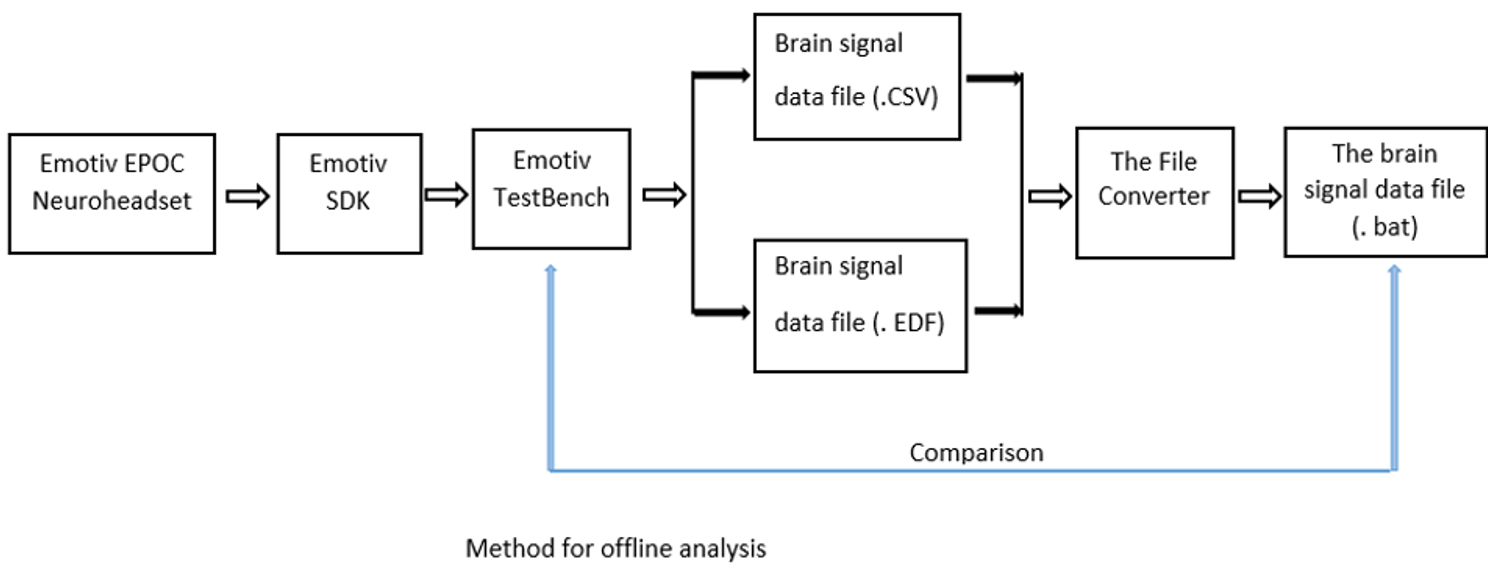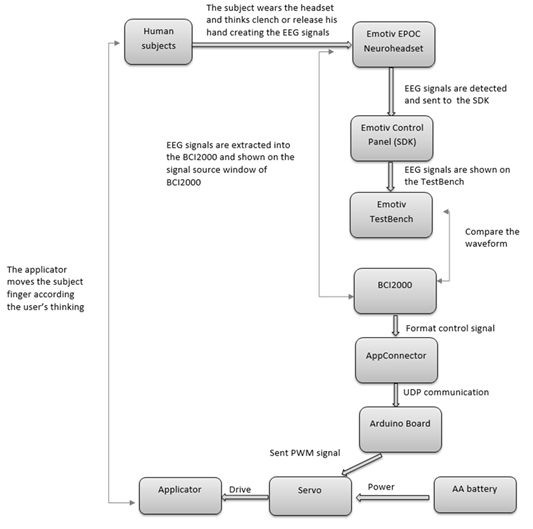Projects:2015s1-35 Brain computer interface control for biomedical applications
Contents
Project Instruction
Objectives
The aim of this project is to design a brain computer interface system for stroke patients. The Emotiv EPOC neuroheadset is used to obtain brain signals, while BCI2000 software platform is utilized to design a signal processing software. A robotic hand is designed to support stroke patient’s hand and give feedback. The system should be able to identify users’ intention of moving fingers, and let the robotic hand move as intended.
Motivation and Significance
According to current researches, on average, for every 10 minutes, an Australian will have a stroke. Besides, stroke costs Australian economy 5 billion dollars a year [23]. In this context, designing a brain computer interface system to help stroke patients regain motor control is a great idea, since this may greatly improve their quality of life and also release the burden on economy.
This project is inspired by the previous work of Traeger and Reveruzzi, which is a similar application of brain computer interface system in biomedical usage [1][2], as well as the earlier work of Wolpaw and McFarland [3][4]. Besides, the theory of Neuroplasticity indicates that by imagining limb movements, neuros in brain may create new pathways instead of the impaired ones to reconstruct the connection with motoring muscles, thus regain control of their limbs. However, these researches mentioned above either focus on arm movement, or uses expensive and complicated devices to achieve robotic hand control. Therefore, we intend to design a cost-effective brain computer interface system that can control robotic hand in this project.
With the help of this system, stroke patients can train their brains so as to rebuild the connection between the brain and motor muscles, and in the end regain motor function. Furthermore, the output of this project may help other researches based on BCI systems, and it can be improved to achieve more complex finger movements.
Requirements
The basic goal of this project is to be able to identify the movement of five fingers, while the optional goal is to be able to identify the movement of each finger individually. Besides, the applicator should be able to move continuously as the user imagines to move.
Background
Brain Computer Interface System
A brain-computer interface (BCI) is defined as a communication system that does not depend on the brain’s normal output pathways of peripheral nerves and muscles [5]. Thus, BCI system is the most direct method of communicating between the human brain and a computer or machine. There are three methods of using BCI: invasive method (signal detection device implanted directly into brain), partially invasive method (devices implanted on the surface of brain and inside the skull), and non-invasive method (collecting brain signal by putting electrodes on the scalp) [6]. Invasive and partially invasive methods can provide high quality signals, however, concerning the safety risks of implanting devices in brain, research in invasive methods mainly focus on non-human primates. In comparison, non-invasive methods are widely experimented on human users because it’s far cheaper and safer, as well as more portable.
Electroencephalography
Electroencephalography (EEG) is the recording of electrical activity along the scalp. It is the most studied potential non-invasive interface, mainly because of its fine temporal resolution, ease of use, portability and low set-up cost. The concept of implementing an EEG signal to control a machine existed as early as the 1970s [7], however, it was not until 1999, when the first experimental demonstration was performed, that neuron activity was used to control a robot’s arm [8]. After that, this field has undergone enormous development. EEG research reflects two major types: evoked potentials (transient waveforms that are phase-locked to an event, such as a visual stimulus) and oscillatory features (occur in response to specific events, typically studied through spectral analysis) [9]. Three kinds of EEG-based BCI have been tested in human beings, and they are distinguished by the unique features they use to determine the user’s intent. Among the three, P300 event-related brain potential is mostly stimulated visually, while slow cortical potentials (SCPs) are mainly used for basic word processing and other simple control tasks. The third one is sensorimotor rhythms, which will be used in this project.
Sensorimotor Rhythms
Sensorimotor rhythms (SMR) are well suited for this project, because its amplitudes change with the imagination of movement (also called motor imagery). These rhythms are 8–12 Hz (μ) and 18–26 Hz (β) oscillations in the EEG signals recorded over sensorimotor cortices. Movement or preparation for movement is typically accompanied by a decrease in μ and β activity over sensorimotor cortex [14]. People can learn to control the amplitudes of the two rhythms without any movement or sensation, and use it to move an orthotic device, such as a robotic hand [6][9][10]. It has been proved that the speed and precision of the multidimensional movement control achieved in human beings by SMR method [3][4] equals or exceeds that achieved so far with invasive methods [11][12]. Various BCI designs using SMR method have proved that it is capable of controlling robotic applicators for stroke patients [3][4][13]. Thus, we used it in this project.
System Design
Signal Acquisition
Signal Processing
Applicator
Project Outcomes
Project Management
Team Members
Supervisors
Work Breakdown
Budget
Risk Analysis
Team
Team Member
Supervisors
References
The aim of this project is to utilize the Emotiv Brain Computer Interface system to develop and control a robotic limb support system for stroke patients. The Emotiv allows non-invasive recording of electrical brain activity (EEG), which will be utilized for controlling an applicator. The Emotiv also includes a software development kit. Students will acquire skills in signal processing, feature extraction and feature classification. Further, the students will gain experience by designing a basic medical device.


